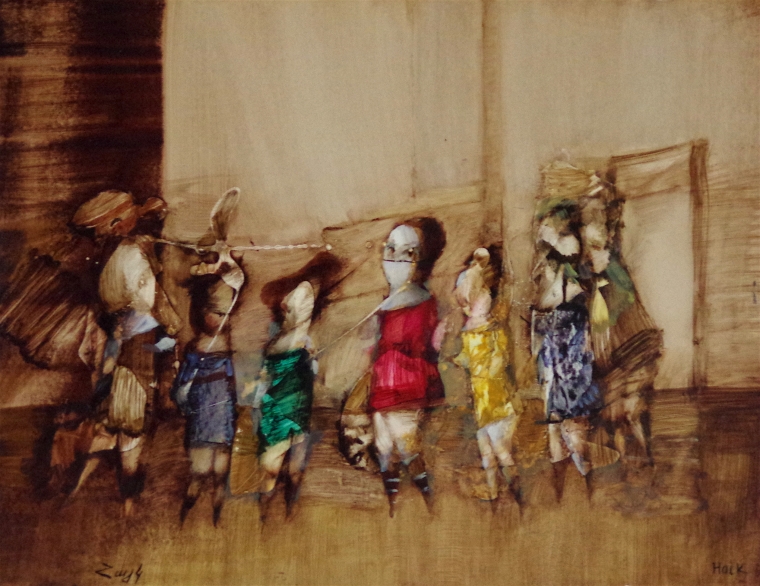The Effect of Figurative Oil Painting on Modern Art and Culture
The Effect of Figurative Oil Painting on Modern Art and Culture
Blog Article
The Function of Feeling and Expression in Metaphorical Oil Painting: A Comprehensive Analysis of Subject and Make-up
The interaction of feeling and expression in figurative oil painting serves as a crucial lens where one can analyze the detailed partnership in between subject and structure. Artists harness various strategies, from color choice to brushstroke characteristics, to grow emotional resonance within their works. This nuanced orchestration not just shapes visitor understanding yet additionally welcomes a deeper questions right into just how these aspects coalesce to mirror the complexities of human experience. As we explore this rich surface, one must take into consideration how particular study light up the wider ramifications of these artistic options.
Recognizing Emotion in Art
Feeling in art serves as an effective channel for expression, allowing musicians to convey intricate feelings with their work. In metaphorical oil paint, this psychological depth is often represented through the depiction of the human figure, recording the nuances of human experience. The choice of subject matter, shade combination, and brushwork all add to the psychological resonance of a piece.
Artists regularly draw upon personal experiences, societal problems, or global styles to stimulate sensations in the viewer. For example, a portrait might mirror vulnerability, while a dynamic number in movement can symbolize liberty or turmoil. These psychological strings connect the audience to the artwork, promoting a dialogue that transcends the visual medium.
Additionally, the interaction between light and shadow can magnify psychological intensity, leading the viewer's gaze and accentuating specific elements within the make-up. Making use of appearance in oil paint further includes layers of intricacy, welcoming a responsive response that improves the emotional experience. In general, understanding emotion in art is important for valuing the nuances that define figurative oil painting, as it changes simple representation into an extensive exploration of the human problem.
Crucial Element of Composition
In the world of metaphorical oil painting, the composition acts as the underlying structure that organizes visual elements and boosts the psychological narrative. Essential elements of composition consist of balance, contrast, focal point, and rhythm, each adding to the general influence of the artwork.
Equilibrium refers to the circulation of aesthetic weight within the painting, which can be attained through balanced or asymmetrical plans. A well-balanced structure offers security, enabling the viewer to engage with the item sympathetically - figurative oil painting. Comparison, on the various other hand, entails comparing various aspects, such as dark and light or warm and cool shades, to direct the viewer's eye and evoke psychological reactions
The focal point is vital, as it directs interest to the most significant part of the painting, commonly highlighting the psychological core of the story. By skillfully integrating these crucial components, artists can craft engaging and mentally resonant metaphorical oil paintings that captivate and involve their target market.
Subject and Its Effect
Subject issue plays a pivotal function in metaphorical oil painting, as it not only works as the structure for the narrative however also shapes the audience's analysis and psychological involvement with the artwork. The selection of subject-- be it a singular figure, a team dynamic, or a thematic depiction-- straight influences the emotional environment conveyed to the audience.

For instance, pictures usually stimulate personal links, disclosing the complexities of human expression and character, while scenes depicting communal activities can produce a sense of belonging or nostalgia. The social and historical context of the subject issue improves the audience's understanding, motivating deeper reflections on societal standards, worths, and the human condition.
Different topics also create differing levels of involvement; a remarkable conflict portrayed with figures in stress might generate sensations of anxiousness or compassion, while tranquil landscapes can conjure up harmony and reflection. Inevitably, the influence of topic in metaphorical oil paint is profound, as it works as a channel for psychological vibration, assisting the audience's action and analysis, and promoting a connection in between the art work and the onlooker. This interplay is necessary for the effective communication of the artist's intent.
Techniques for Stimulating Feelings
The efficiency of figurative oil paint in sharing emotions is dramatically affected by the methods utilized by the musician. One of one of the most vital methods is making use of color theory, where the calculated choice of hues can evoke particular psychological reactions. Warm colors, such as oranges and reds, commonly evoke feelings of passion or aggression, while cooler tones like blues and greens often tend to evoke calmness or unhappiness.
Another important technique is the control of light and darkness, known as chiaroscuro. This approach enhances the three-dimensionality of numbers, developing remarkable contrasts that can escalate psychological depth. The positioning of light can direct customers' emotions, highlighting details aspects of the structure.
Brushwork also plays a crucial function; loose, meaningful strokes can convey energy and spontaneity, whereas smoother techniques could recommend peace or accuracy. Additionally, the arrangement of topics within the structure can affect emotional effect. Close distance can suggest affection, while distance might indicate seclusion.
Ultimately, the combination of these methods makes it possible for artists to craft stories that resonate with the audience, transforming a mere visual experience into an expressive psychological trip. - figurative oil painting

Situation Researches of Noteworthy Works
Taking a look at noteworthy works of metaphorical oil painting reveals how numerous strategies are utilized to stimulate powerful emotions. One excellent instance is Edvard Munch's "The Scream," where the altered figure and swirling background communicate existential dread. Munch's use color-- dazzling oranges and deep blues-- magnifies the emotional influence, showcasing exactly how palette selections can shape visitor experience.
One more substantial work is Pablo Picasso's "Les Demoiselles d'Avignon." Below, bold brushstrokes and fragmented types reflect a troubled emotional landscape, challenging typical representations of the women number. Picasso's cutting-edge structure not just records the customer's attention but also welcomes contemplation on themes of identity and sexuality.
In Addition, Frida Kahlo's "The 2 Fridas" provides a touching exploration of duality and self-identity. The contrasting numbers, connected by a common heart, exhibit Kahlo's psychological depth image source and personal narrative. figurative oil painting. helpful site Her careful attention to information and symbolic elements offer to engage viewers on a natural level
These study highlight the extensive connection between feeling and make-up in figurative oil painting, revealing how musicians harness method to interact complicated feelings and narratives that reverberate throughout time and culture.

Final Thought
In verdict, the interplay of feeling and expression in figurative oil paint dramatically boosts the audience's experience and analysis of the art work. Through a mindful choice of topic and compositional techniques, musicians share profound stories that resonate on both personal and global levels. The application of shade theory, chiaroscuro, and brushwork additional magnifies psychological depth, transforming each canvas into a powerful representation of the complexities of the human experience.
In metaphorical oil painting, this psychological depth is usually portrayed through the representation of the human figure, catching the nuances of human experience.Furthermore, the interaction in between light and shadow can intensify psychological strength, directing the viewer's gaze and attracting focus to specific elements within the make-up. The usage of texture in oil paint additionally adds layers of complexity, inviting a tactile action that improves the emotional experience.The focal point is critical, as it guides focus to the most considerable component of the paint, commonly highlighting the psychological core of the narrative. Ultimately, the effect of subject matter in metaphorical oil painting is profound, as it serves as a conduit for psychological vibration, assisting the viewer's action and interpretation, and promoting a link between the art work and the i loved this observer.
Report this page